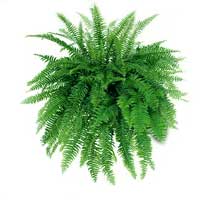Nephrolepis / nephrolepis
Refers to the family of ferns.
General description: Nephrolepis - the most unpretentious of ferns, hastily grows and quite beautiful. Usually it is grown like an ampel plant.
Usually in the room conditions the following species are bred:
Nephrolepis exaltata (Nephrolepis sublime) owns rigid cirrus erect leaves with even margins. It grows up.
Nephrolepis exaltata bostoniensis (Nephrolepis Boston) . This variation is distinguished by delicately curved leaves.
There are similar varieties with corrugated edges of leaflets, with complex feathery forms (twice, thrice and four times dissected), at what time each leaf is in its turn pinnatized and the entire plant looks lacy.
Recommendations for caring for the plant Nephrolepis:
Illumination : Needs bright, but diffused light.
Irrigation regime : Abundant during the growth period, moderate in winter. To water with warm soft water.
It is recommended to water the method by immersing the pot in a tray with water up to a full saturation.
He does not adore in any way the overflow, nor the drying out of the earth.
Humidity : Needs frequent spraying, especially in summer or in a well-heated place. He does not like drafts.
Remove from central heating.
Temperature regime : In summer the temperature should be moderate 20-22 ° C, in the winter cool 13-15 ° C.
Soil : The soil is weakly acidic. When a snow-white calcareous deposit appears on the surface of the soil, the top layer must be replaced.
Recommended soil mishmash: 1 share of light turf, 1 share leafy, 1 share peat, 1 share humus and 1 share sand.
During the growth period, it needs fertilizing once every 2 weeks with complex fertilizers for ornamental-deciduous plants.
Breeding: Crushing the bush in spring, layers.
Transplantation : Transplanted in the spring, at what time the pot is made tight (the roots begin to germinate through the drainage holes).
Pests : Affected by a spider mite (in a dry atmosphere, leaves and stems are braided with cobwebs), scabbards (brown plaques appear on the leaves and stems, leaving sticky discharge).
The plant is allowed to help finish with a soap solution, warm washing and spraying with an actinic (1-2 ml per liter of water).

Nephrolepis - nephrolepis


Comments
Commenting on, remember that the content and tone of your message can hurt the feelings of real people, show respect and tolerance to your interlocutors even if you do not share their opinion, your behavior in the conditions of freedom of expression and anonymity provided by the Internet, changes Not only virtual, but also the real world. All comments are hidden from the index, spam is controlled.